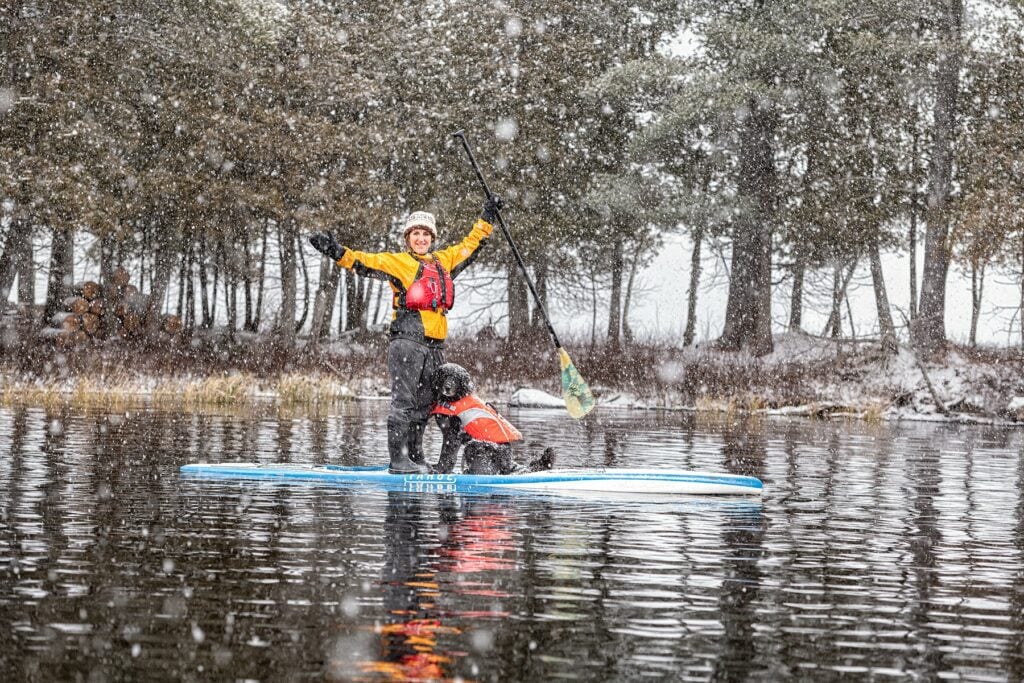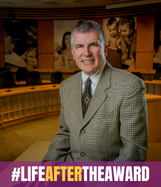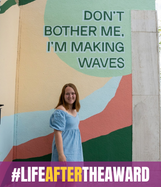By Kimmi Nguyen-Fonseca
Feature image: Mark Reeder
Laurie Stimpson (Silver ’83, Gold ’92) applied the networking, adaptability, and goal-setting skills she gained from her Duke of Edinburgh’s Award from nearly thirty years ago to help build her business. She still uses those skills to grow her business today. Being an entrepreneur has also given Laurie the flexibility to pursue interesting opportunities along the way.
Laurie’s fondness for nature is evident in her living space and the company she keeps. A view of the woods can be enjoyed through glass doors leading out to the deck, while exposed timber beams decorate her home’s interior. As her dog woofs, Laurie laughs. “He’s a border collie, golden retriever, Labrador retriever. Loves water, loves nature, and just a bit barky.”
She’s married to Rob, a photographer who has worked with clients such as Parks Canada, Ontario Parks, and Ontario Tourism. They first met when she was completing a co-op placement at Crawford Lake.
After graduation, Laurie worked at an outdoor education centre in Lindsay for several years, before returning to Crawford Lake. The two rekindled their friendship over their shared enthusiasm for the outdoors and it didn’t take long for them to fall in love.
What sparked your passion for the outdoors?
When my family lived in Toronto, my dad would take us out of the city with other like-minded people from church who also had kids. We would go camping and canoeing. This was back in the 80’s and at the time it was like a 3-hour drive away, but some of those areas we went to are close to where I live now.
I’m happiest when I’m outdoors. Being outdoors is so great for mental health and I think when people can do their passion, whatever that is, it’s huge.

Laurie likes being outdoors year-round. Here she paddleboards with her dog, Safari. (Courtesy of Laurie Stimpson)
When I was 11, my parents moved us out to Scarborough and then Hornby, which was close enough so Dad could commute to Mississauga for work. We still kept in touch with the same families from Toronto to go canoeing with them.
I got involved with Scouts Canada and worked on my Silver Award with three others. For my skill, we built our own kayaks from ash and bent it over the winter in one of the Scout leader’s garages that had a woodworking shop. Stuff like that was really fun and hands-on!
What did you decide to study in post-secondary?
I find that age hard because we’re trying to make decisions, right? By that point I had been doing lifeguarding and teaching swimming to kids. I thought maybe I would become a Phys Ed teacher.
After a year at university, I found it wasn’t quite what I was looking for. I preferred more of a hands-on type of learning, so I decided to change my path and went to Fleming College.
I learned how to identify trees by bark, took courses in fish and wildlife, and studied how the national parks and provincial parks systems were set up. It was terrific! In my second year, I did my co-op placement at the Crawford Lake Conservation Authority.
What drew you to pursue a career path in an outdoor setting?
After I graduated with my Parks and Forest Recreation diploma, I stayed in Lindsay and worked at an outdoor education centre, developing programs for students from Fleming College to gain work experience with teaching.
My former teachers became peers who provided me with advice. Some of the college students ended up completing part of their co-ops at this outdoor education centre. The college then offered me a job as a Liaison Officer, but I turned it down because I really wanted to do something that had to do with nature. I was also missing my family.
I moved back home to live with my mom and dad and went back to Crawford Lake to teach education programs. That turned into a permanent position after I filled a maternity leave position, and I became the Park Acting Manager for 8 months.

Laurie (back, left) enjoys teaching paddleboard classes for individuals, couples, private groups, and corporate teams. (Muskoka Paddle)
Is there a story behind how you met your husband? How did you two come to work together?
Rob was also working at Crawford Lake; he had been working there while I was doing my co-op years ago, and we had met then. We got talking about the places where we canoed, comparing stories. If there was a place Rob canoed where I hadn’t gone, he would bring me a map to show me the route he took.
Rob also had a second job elsewhere and when he would come in from after work, we would go skiing together. We were already friends; we liked a lot of the same things. From there it blossomed into more romance, and we decided to get married. I continued to work at Crawford Lake for another couple of years and we started an adventure company together doing outdoor guiding.
While we were trying to run our guiding company, Rob and I worked freelance. I helped Arrowhead Provincial Park with their Jackrabbit Nordic ski program and kids programming. Rob picked up photography contracts here and there working for parks. Later, I had a chance to go on a work trip with him down to Antarctica. I was so excited to see all the species of penguins that live there! It was incredible. We never would have been able to do that had we stayed working in other jobs that came up along the way.
What types of outdoor guiding did you do?
We did canoe guiding and some of the most success we had with our company were women only canoe trips called “Leave the Men at Home” with 7 or 8 women, me, and another guide. Those were a lot of fun!
In the winter, we organized snowshoe trips and little retreats for couples. We even dabbled in hiking trips and ran a trip down to the Grand Canyon for three clients just to see if we can build the shoulder season. It was very successful, but we found you need a certain type of clientele to do that. Most people want to see the Grand Canyon from the rim, not to actually hike to the bottom and back with a pack!
What challenges did you two encounter while running your outdoor guiding business?
For us, with supporting each other and being a couple, I think part of my journey has also been realizing what it takes to be in a relationship. When Rob’s photography career took off, we decided it was important for me to support him through that. He was doing contract work. At that point, I got a permanent job. Seeing as there was a new Home Depot opening in the area and because I enjoy renovating, I sent in my resume.
While I was working in the seasonal and gardening department, I brought my love of nature to the role. Rob helped me print tags that showed which plants were suitable for hummingbirds, and I stuck them in with toothpicks. Suddenly people started noticing how many plants were ‘hummingbird approved’, and I encouraged them to bring those types of plants into their gardening. All plants now come in with these sorts of tags, but back then it didn’t.
Even when you weren’t working outdoors, were you inclined to do outdoor activities?
Rob and I still went out canoeing together. While he was on work trips to the Arctic, I realized a canoe was a bit heavy for me to bring in and out of the water myself.
I learned how to paddleboard— Rob actually bought me my first paddleboard. When he wasn’t home, I could easily pick up a 25-pound paddleboard and take it on the lake with our dog. Paddling has always been part of my life.

Practicing SUP yoga has led Laurie to master the skill of a headstand pose on the paddleboard. (Courtesy of Laurie Stimpson)
What motivated you to start Muskoka Paddle? How did you get started with launching your own company?
During the pandemic, I think we all had a chance to think of what’s important to us. At that point, my husband was well set in his business. I decided it was the right time to do something for myself, to return to my passion.
I wasn’t sure how I would get there but the Award was great at teaching me how to identify the ideal end goal, to pick one area to start, and to work with people. I was able to apply my background with designing lesson plans, building outdoor education programs and special events at Crawford Lake. It all came together.
Can you share some of the challenges you encountered with starting a business and how you dealt with them?
Over 9 months, I was still working 5 days a week at Home Depot and then coming home to work on my business.
I was most worried about my website. I could build a website on my own down the line, but I chose to hire that out. I was really glad to have someone help with that because at the same time, I was doing research to buy paddleboards for the business and sourcing out insurance.
I managed to secure the paddleboards that December and tested them right here on our lake. As I carried an inflatable board down the trail and popped it in the water, I wondered if it would do okay in those temperatures. There were certainly bumps along the way and I had enough to work on.
What other aspects of the Award have you integrated into your business?
I worked with a friend to start a Witches Paddle. People come dressed as witches, warlocks, and sea creatures even! It’s all to raise money for a cause and all volunteer-run.
Last year we raised money for Enliven Cancer Care. The stories shared by the women I was standing on the dock with, who have used Enliven… some of them told me they drove over three hours here because they saw who we were raising money for and they wanted to be involved, to participate.
It’s great to get back into volunteer work in that way. The partnerships that I’ve made through it have been great. The volunteer work that we do goes a lot further than what we see.

Muskoka Paddle hosts an annual Witches Paddle event to raise funds for charity. (Rob Stimpson Photography)
What other collaborative efforts has your business been involved in?
I partner with a pizza place in the area for clients who want to do a pizza party here after they paddleboard. It’s been neat to see the bonding that continues to happen after the paddleboarding experience, with people sitting there enjoying pizza and talking about their time together.
How do you bring your values of environmental sustainability and respecting the land into your work?
I take pride in choosing a recreation activity that doesn’t harm the earth. Paddling is the traditional craft of our nation’s first people. I try to read up about the history of the area and the First Nations. I share about this in some of my classes.
When we’re out on the water, I will talk to the paddlers about the sound of the wind in the pines, the sound of the rain, the sound of the waves. I bring awareness to the aromatic essential oils present in pine and cedar trees around them. There’s a healing component to it all. It’s very soothing. People can take in their surroundings, and I help them have a fun and safe experience.
What advice would you give someone who is considering starting their own business?
Don’t be afraid to communicate and build partnerships. I have a whole team of people I feel supported with and whom I can reach out to. Try new things. It’s important to be open to other people’s ideas. Someone recommended I do a social paddle; I tried it, and it got quite a bit of interest for the business.
If you have a dream, keep at it, don’t get discouraged. I’m still in the building years of my business and some of the big outfitters are starting to refer people to me.
One thing I didn’t realize is what I can write off on my taxes. Having your own business allows you to write off a portion of your phone bill, your mileage. It’s not why you do the business, but it’s a nice benefit.
What was your most memorable Award experience?
I did a 10-day dog sledding and skiing trip with Outward Bound north of Thunder Bay for my Gold Project. I wasn’t sure how I felt about it at first, but it ended up being the best thing I ever did. I was so thankful the Award sponsored part of the fee and I covered the rest of it with the money I earned from my part-time work.
When we arrived at the airport, the guides greeted us, and I met my fellow peers that would also be on the trip. We were given our gear, then got on this little bus. They drove us on the highway for a couple of hours and it was starting to get dark when they stopped.
When we got out, I remember the snowbanks were so big they were up over my head. Over the snowbanks we went, and I could hear the barking huskies! When I had heard the forecast was -35°, I thought surely the first night will be in cabins, but to my surprise, we stayed in the quinzhees they built for us.
We all learned how to work together as a team. We were skiing and moving every day. Sometimes the cheese or salami in our lunch would be frozen. You would have to warm it between your clothes layers, so it thaws.
On the last two days, we had to survive the nights on our own. The guides would come by to check on us the next day. We camped a kilometre and a half from each other. When you get to your site, there’s nothing there and you have to build your own shelter. I was given a tarp, a little pot with five matches, and a fire bow. Before, everything was done communally and suddenly you’re on your own. It’s as much of a mental challenge as well as a physical challenge.
While out there, we were encouraged to sketch or do some art. I have this image of me with my fire bow getting my fire going. I’m so proud! It’s something I still keep with my most valuable personal items.
When things get a little hard with my business, I would think back to that experience. It made me realize I can do anything I put my mind to.
Share this...
More Stories Like This






